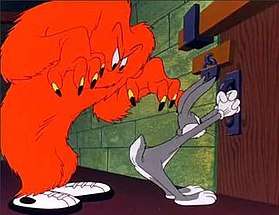Gossamer (Looney Tunes)
Gossamer is an animated character in the Warner Bros. Looney Tunes and Merrie Melodies series of cartoons. He is a large, hairy, orange monster. His body is perched on two giant tennis shoes, and his heart-shaped face is composed of only two oval eyes and a wide mouth, with two hulking arms ending in dirty, clawed fingers. The monster's main trait is his uncombed, orange hair. He originally was voiced by Mel Blanc and has been voiced by Frank Welker, Maurice LaMarche, Joe Alaskey, Jim Cummings, Kwesi Boakye, and currently Fred Tatasciore.
| Gossamer | |
|---|---|
| Looney Tunes character | |
 | |
| First appearance | Hair-Raising Hare (1946) |
| Created by | Chuck Jones |
| Voiced by | Mel Blanc (1946–1980) Frank Welker (1990) Maurice LaMarche (1995) Jim Cummings (1996–2006) Joe Alaskey (2000–2001) Kwesi Boakye (2011–2014) Fred Tatasciore (2020-present)[1] |
| In-universe information | |
| Species | Monster |
| Gender | Male |
| Nationality | American |
The word gossamer means any sort of thin, fragile, transparent material. In particular, it can refer to a kind of delicate, sheer gauze or a light cobweb. The name is meant to be ironic because the character is large, menacing, and destructive.[2]
History
Animator Chuck Jones introduced Gossamer in the 1946 cartoon Hair-Raising Hare. In it, Bugs Bunny is lured to the lair of a mad scientist (a caricature of actor Peter Lorre[3][4]) as food for Gossamer. The monster (Gossamer) serves as the scientist's henchman.
Part of this plot was repeated in the 1952 Jones cartoon Water, Water Every Hare[5] in which the monster's character is referred to as "Rudolph" or simply "Monster". The mad scientist, in need of a live brain for his giant robot, releases Monster from his chamber on a mission to capture Bugs Bunny; the Monster shows a sudden burst of joyousness and quickly sets out when the mad scientist promises the reward of "spider goulash" for capturing the rabbit. The monster next appears in Duck Dodgers and the Return of the 24½th Century in 1980. This is the first cartoon where the character is called "Gossamer", and is so named by Marvin the Martian. Jones gave the monster this name "because he's the opposite looking of gossamer. He's a big, hairy thing."[2]
Gossamer also has appeared in various recent Warner Bros. productions, including cameos in the 1996 film Space Jam and as a playable character in the video games Looney Tunes: Acme Arsenal, Looney Tunes: World of Mayhem and Looney Tunes: Back in Action. Gossamer appeared in the Aaahh!!! Real Monsters episode "Monsters Are Real" where he was shown as one of the best monsters to scare people and animals. Gossamer appeared in the television series Beetlejuice as a redesign named "The Monster Across the Street".
Gossamer was going to have a cameo in Who Framed Roger Rabbit, but the rights to him could not be obtained in time.
Gossamer appears in The Looney Tunes Show voiced by Kwesi Boakye. Gossamer here is the opposite of previous portrayals, being a timid and kind child. He has a bond with Daffy Duck, who serves as a sort of mentor and father figure to him despite Daffy’s rivalry with Gossamer’s mother Witch Hazel.
In the most recent series, Looney Tunes Cartoons, he is back to his classic role as a monster who hunts Bugs Bunny down.
References
- https://collider.com/looney-tunes-cartoons-characters-hbo-max-images/
- Korkis, Jim. "The Return of Duck Dodgers". Outré magazine. 1 (7). p. 86.
- Greenberg, Harvey Roy (2004). "Heimlich Maneuvers: On A Certain Tendency of Horror and Speculative Cinema". In Shneider, Steven Jay (ed.). Horror Film and Psychoanalysis: Freud's Worst Nightmare. Cambridge University Press. p. 130. ISBN 9781139453684.
- Youngkin, Stephen D. (2005). "Being Slapped and Liking It". The Lost One: A Life of Peter Lorre. University Press of Kentucky. p. 214. ISBN 9780813137001.
- Beck, Jerry; Friedwald, Will (1989). Looney Tunes and Merrie Melodies: A Complete Illustrated Guide to the Warner Bros. Cartoons. Henry Holt and Co. pp. 234–235. ISBN 0-8050-0894-2.